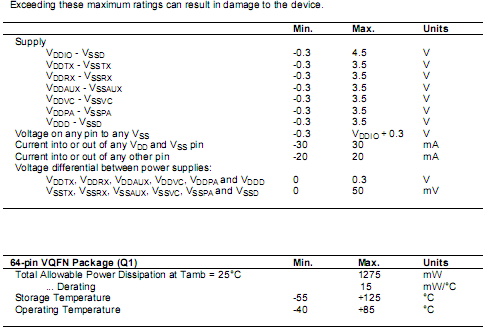Features: Programmable Digital Tx and Rx Filters
High Performance Codecs
Radio Rx: 2 x 16-Bit Sigma Delta ADC
Radio Tx: 2 x 14-Bit Sigma Delta DAC
Auxiliary: 6 x 10-Bit ADC
Auxiliary: 4 x 10-Bit DAC
Voice: 14-Bit Linear with Digital Filter
/4 DQPSK and Other Modulations
Full Duplex Operation
C-BUS and 3 Fast Serial Bus Interfaces
Low Power for Portable Terminals
2.5V Supply With 3.3V Tolerant I/O
130mW Speaker Amplifier (8WW load)
Specifications Description
DescriptionThe CMX981 Advanced Digital Radio Baseband Processor is a combination codec/processor that interfaces analogue and digital sections of a Digital Radio System and performs critical DSP-intensive functions. The device supports portable, mobile and base station TErrestrial Trunked RAdio (TETRA) system applications and is also sufficiently flexible for use in other demanding digital radio systems.
The CMX981 transmit path comprises all functions required to convert digital "symbol" data into suitably filtered analogue I and Q signals for external up-conversion and transmission. This includes digital control of output amplitudes and offsets and fully programmable digital filters. Default coefficients provide the root raised cosine (RRC) response required for TETRA.
The CMX981 receive path accepts differential analogue baseband I/Q signals, samples them and performs digital channel select filtering to simplify host processing and data extraction. Internal digital offset correction and the digital filters are fully programmable. Default coefficients provide the RRC response required for TETRA.
Auxiliary DAC and ADC functions are included for the control and measurement of the radio system RF section. CMX981 may include AFC, AGC, RSSI, or part of the control system for a Cartesian loop.
The CMX981 voice codec converts voice signals to and from digital form and can be configured to apply a digital voice filter per specification G.712. The CMX981 encode path accepts a differential analogue audio input signal, converts it to digital form and applies digital voice filtering to produce a processed digital stream. The decode path accepts a digital stream written to the serial interface, applies digital voice filtering, converts the result to an analogue signal, and presents the signal at
differential speaker or single-ended earphone analogue driver outputs. This path also includes sidetone addition and a ring tone generator.

 CMX981 Data Sheet
CMX981 Data Sheet







